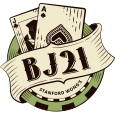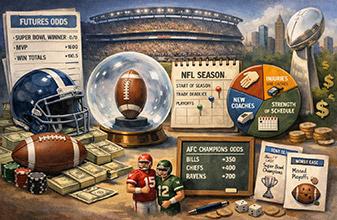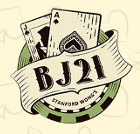Sports betting EV examples

King Yao is the author of Weighing the Odds in Hold‘em Poker, and Weighing the Odds in Sports Betting. He uses his experience from making millions in financial derivative markets and translates it into gambling. Since he left his trading position in 2000, he has been playing poker and betting on sports. He travels to Las Vegas frequently, especially during football season.
Let’s discuss basic principles of sports betting. All sports bettors should know the information below. All other types of casino advantage players, including blackjack players of all skill sets, including card counters, should have good working knowledge of Expected Value as well.
You should not be betting online or anywhere else without this fundamental knowledge.
Most lines that sportsbooks offer are efficient. On most point spread wagers, the sportsbook collects the juice in that you have to risk more than you can win on a straight bet. If the bet has a 50% chance of winning, then the sportsbook has positive Expected Value against you. Here is a sports betting EV example. The Celtics are a 3.5 point favorite against the Knicks. The sportsbook has set a good line and there is a 50% chance of either team covering the point spread.
You go to the window and bet $110 to win $100 on the Celtics -3.5. Here is your EV on the bet if you have a 50% chance of winning it:
EV of Celtics -3.5 -110
= (50% x $100) + (50% x -$110)
= -$5
If most lines on the board are efficient, then most bets made by bettors have negative EV from the point of view of the bettors. The sportsbook has the disadvantage of not choosing which team you will bet on. But if the book sets all lines reasonably correctly, then it holds a big advantage over most gamblers.
You should try to put yourself into situations where you have positive EV. Winning requires being able to distinguish between situations with positive EV and situations with negative EV. When you find a positive-EV bet, jump on it. When you see a negative EV bet, pass. Losing sports bettors are not able to distinguish between positive and negative EV, so they often make negative-EV bets.
Square bettors (squares) are people who often make negative EV bets. Sharp bettors (sharps) are people who often make positive EV bets. Semi-sharp bettors often make the same plays as sharp bettors, but who may not have the ability or the knowledge to adjust or adapt as quickly.
Money Line
The betting line on a participant (usually a team or a person) to win an event outright is expressed in terms of money lines. Examples are: the Yankees -150 to win the game; the Mets +650 to win the National League championship.
If the money line is negative, you have to risk that amount in order to win 100. For example, -129 in the money line means you have to risk 129 to win 100.
If the money line is positive, you have to risk 100 to win that amount. For example, +109 in the money line means you have to risk 100 to win 109.
Converting a money line into percentage
Convert a money line into its equivalent win percentage by dividing the amount you risk by the amount your ticket will be worth if your bet wins. The ticket amount is your win plus the amount you Bet.
If the money line is negative, then take the money line and divide it by itself minus 100. For example, a money line of -129 converts to 56.3%:
= -129 / (-129 -100)
= -129 / -229
= 56.3%
If the money line is positive, then take 100 and divide it by the money line plus 100. For example, a money line of +109 is converted to 47.8%:
= 100 / (109+100)
= 100 / 209
= 47.8%
Converting percentage into a money line
If the percentage is greater than 50%, then divide it by 100% minus itself, and multiply by -100. For example, 55% is converted to -122
= PERC / (100%-PERC) x (-100)
= 55% / (100%-55%) x (-100)
= 55% / 45% x -100
= 1.22 x -100
= -122
If the percentage is less than 50%, then take 100% minus itself divided by itself, then multiply by +100, then put a plus sign in front of it. For example, 45% is converted to +122
= (100% - PERC) / PERC x 100
= (100% - 45%) / 45% x 100
= 55% / 45% x 100
= 1.22 x 100
= +122
Exactly 50% can be expressed as both +100 and -100.
Point Spread
A point spread is an artificial adjustment to the score of an event in order to determine a winner and loser for a wager. The favorite lays points and the underdog gets points. If the point spread is -5, there are three ways to compare the favorite to the underdog:
- Subtract 5 points from the favorite’s score and compare the result to the underdog’s score.
- Add 5 points to the underdog’s score and compare the result to the favorite’s score.
- See how many points the favorite won by, and subtract 5 points. If the result is a negative number or the dog won outright, then the dog beat the point spread.
Sportsbooks typically put up point spreads that approximately divide the action among bettors and/or equally divide the chances of either team covering the point spread. Without any other information or opinion on the line, bettors should assume point spreads are fairly efficient. However, they are not always efficient, and this is when the smart sports bettor can take advantage of the Sportsbooks.
Sportsbooks change point spreads with new information. New information can be: heavy money being bet on one side; seeing money bet by certain bettors whom the sportsbooks respect highly; news about the participants in the event (such as injuries, suspensions, etc.); and following other sportsbooks that have moved their line (called moving on air).
Once you place a bet, the terms of the bet are fixed. The point spread may change as regards new bets, but the terms of an already-made bet will stay as written. Betting sports is not the same as pari-mutuel betting in horse racing.
Point spreads have accompanying money lines as well, called the vigorish, the vig or the juice. Typically, the vig is -110; you have to risk 110 in order to win 100. Sometimes the sportsbook will have a vig different from -110; instead of adjusting the point spread, the book may adjust the vig. For example, if the sportsbook gets considerable action on a team at -3 -110, it might change the terms to -3 -120.
Some sportsbooks offer reduced juice, some all the time and some during certain times of the week. Instead of -110 juice on point spreads, a book may offer -107 or -105. Some sportsbooks in Las Vegas offer reduced juice on the Super Bowl to attract business.
This is part of an occasional series of articles.
Excerpted with permission from the e-book version of Weighing the Odds in Sports Betting by King Yao, edited for this format.











Please log in or register to leave a comment